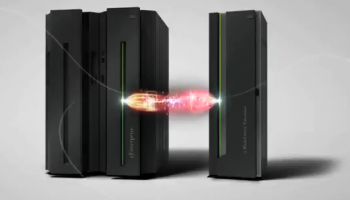IBM Launches 5000 MIPS Hybrid Mainframe

IBM’s zEnterprise server pushes mainframe performance on, and converges mainframe technology with blade servers
IBM has launched the zEnterprise Server, claimed to be its most important mainframe for 20 years, and introducing a new architecture which combines z Series with blade servers inside one footprint.
The new system will extend mainframe qualities to IBM’s AIX and Linux servers – the Power7 and System x ranges – by putting all the servers under one hood managed by the same “unified resource manager”, according to IBM’s press release.
First generation hybrid computers
 “This is the first stage of a $5 billion (£3.3bn) R and D program – and today’s announcement is the first $1.5bn of it,” Barrie Heptonstall, IBM’s mainframe and power sales leader for the British Isles told eWEEK Europe UK, the day before the launch.
“This is the first stage of a $5 billion (£3.3bn) R and D program – and today’s announcement is the first $1.5bn of it,” Barrie Heptonstall, IBM’s mainframe and power sales leader for the British Isles told eWEEK Europe UK, the day before the launch.
As well as scaling up IBM’s mainframe performance to a 5000 MIPs machine – the fastest anywhere, he claimed – the announcement brings IBM’s different blade offerings under the same management and control as the mainframe.
While other vendors such as HP have criticised IBM for continuing users’ dependence on mainframes, and governments have investigated its alleged monopoly, IBM maintains that demand for the highly reliable servers continues unabated and increases.
The new mainframe is up to 50 percent faster than the current System z103, and potentially more energy-efficient, running 60 percent more work than the z10 for the same amount of energy.
Up to 112 IBM blade servers inside the IBM zEnterprise BladeCenter extension – a rack next to the mainframe itself – can be managed like mainframe resources but run off-the-shelf applications normally put onto blade servers. The idea is that data centres which contain a jumble of technology get a single view of it through one management system.
Also, explained Heptonstall, most applications now involve co-operation between code on different servers. This can now happen much more quickly, through a 10Gbps private network within the zEnterprise machine, instead of across a data centre network. “That eliminates up to ten steps and makes the operation more efficient,” he said.
Efficient, scalable processing
The hybrid mainframe concept has been tested with users including Citi Bank, who have reacted favourably. “The new IBM zEnterprise System represents a potentially revolutionary change to the platform and the next phase in the evolution of highly efficient, scalable processing, opening up the possibility of hosting entire workloads on a single highly integrated system,” said Martin Kennedy, Managing Director, Citi’s Enterprise System Infrastructure. “The new zEnterprise also paves the way to enhance the energy dynamics of our data centres.”
The zEnterprise 196 – the first of the new mainframes – contains 96 of the latest version of IBM’s mainframe chips, which operate at 5.2Ghz, and the whole machine can execute more than 50 billion instructions per second. For more efficiency, there is a water-cooling option – something IBM says could be in all servers in ten years.
The processors can include “speciality engines”, designed for specific tasks, such as the z Application Assist Processor (zAAP) for integrating Java workloads with core business applications, the System z Integrated Information Processor (zIIP) designed to help free-up computing capacity and lower IT costs, and the Integrated Facility for Linux (IFL) to optimise Linux workloads running on the mainframe.